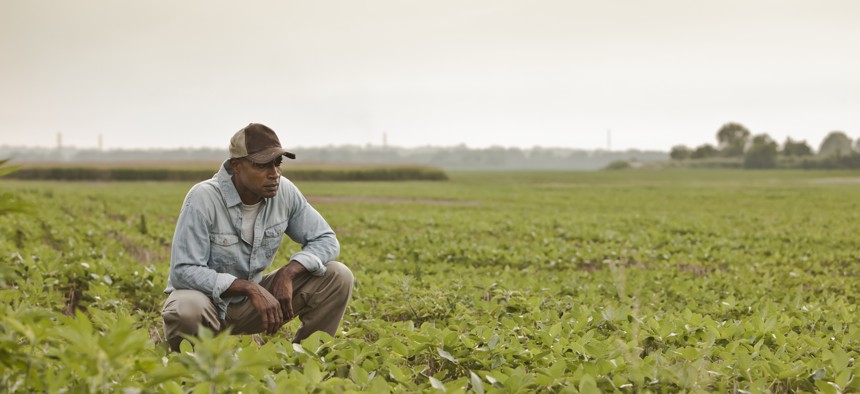Food for thought: Data tool maps food, climate and racial equity risks

John Fedele/GettyImages
A new data tool breaks down existing data and policy silos so state and local governments can identify and reduce those interconnected risks.
Record heat and drought baked farmland in much of the country for the second year in a row, driving food availability down and prices up.
In fact, the American Farm Bureau Federation estimated that the 2022 climate-related damages came to more than $21.4 billion in crop and rangeland losses. Drought conditions in Kansas, for instance, led to more than $3.3 billion in damages to corn, grain and soybean crops. Those losses and the resulting rise in food prices are leaving some families struggling to put food on the table.
Food insecurity and climate change are serious enough threats on their own, but according to a new study, addressing the issues separately won’t be enough to prepare communities—especially communities of color—against future environmental and agricultural risks.
The study, released last month from the Urban Institute, urged state and local leaders to ensure their communities’ and their local food systems are resilient against incoming climate hazards.
To help policymakers learn more about local climate-related food insecurity, the Urban Institute’s Racial Analytics Lab released a new data tool that identifies U.S. counties where communities of color are most vulnerable to food insecurity and climate change hazards. Data insights from the tool can supplement and inform how communities adapt to and mitigate the negative effects of disruptions to food production and accessibility, said Kassandra Martinchek, co-author of the study and research associate in the Center on Labor, Human Services and Population at the Urban Institute.
With the tool, users can see where more efficiently targeting resources or policy interventions could reduce the impact of climate change and food insecurity on under-resourced communities, researchers wrote. It could provide data, for example, to inform investments in renewable agriculture or grants to Black and Latinx farmers to support food production in areas threatened by climate hazards, the report said.
The tool pulls data from the American Community Survey, the U.S. Department of Agriculture’s data on food production and the nonprofit Feeding America that maps U.S. food insecurity rates. Data on climate-related damage from events like drought, flooding and wildfires is provided by Arizona State University’s Spatial Hazard Events and Losses Database.
The tool identified 47 counties in the U.S. currently facing intersecting climate change, racial equity and food security vulnerabilities. These high-risk counties had higher food insecurity rates and experienced heightened climate risks, such as wildfire, drought and flooding. In the 47 counties, for example, the average cost of climate damage was $5,466 per capita between 2011 and 2021. According to the study, that’s nearly double the average cost for counties at less risk of climate change—$2,745. And for Black and Latinx households in high-risk counties, 26% are food insecure on average, while 18% of households in less vulnerable counties are food insecure.
The compounding threats of climate risk and food insecurity, Martincheck said, can also exacerbate long-standing racial inequities. Historic under-investment in those communities, for example, has resulted in communities with larger populations of color receiving less financial assistance for disaster recovery. Residents also risk developing chronic health conditions from malnutrition, she added.
“Food systems, climate resilience and racial equity are really deeply interconnected in how they operate at a systems level, but a lot of data and policy discussions are relatively siloed,” Martincheck said.
One way state and local leaders can address the triple threat of climate change, food insecurity and racial inequity, researchers said, is to collaborate with community-based partners. Collaborating with community groups and leveraging the data tool can help officials “generate insights that support vulnerable communities and drive their ability to develop and sustain resilient and equitable local food systems,” the report said.
Feedback from local organizations indicated that they anticipate “a lot of potential use cases” for the data, Martincheck said. It can help community and government leaders address local drivers of climate and food insecurity risks, for instance, or reveal communities that were previously thought to have low vulnerability.
The tool can also help counties identify others facing similar climate change, food insecurity and racial inequity issues—even counties halfway across the country. “By identifying communities with shared challenges, localities can understand how different factors affect food systems’ resilience, share resources and explore mutually beneficial strategies,” the report stated.
Cross-county collaboration is the goal of the Northeast Regional Food Business Center, a network of state agriculture officials, universities and nonprofits across 11 states and the District of Columbia. The program looks to build regional food system resilience by, for example, offering small and mid-sized food producers technical assistance with grant writing or financial literacy, said Chris Jones, senior director of the National Association of State Departments of Agriculture Foundation. The center will also offer businesses grants to improve food production and processes, such as enhanced irrigation or cold storage systems.
Having an open dialogue with leaders from different Northeast states could strengthen regional resilience to climate change and food insecurity. It can also help officials see how solutions working in one area could be successful in a similar community elsewhere, Jones said.
Ultimately, state and local officials should “think more deeply about place-based solutions or areas that need more resources to be able to provide a counterweight against these challenges that they're facing,” Martincheck said.






